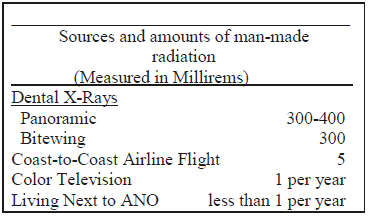What is an emergency?
Many things could cause an emergency at a nuclear power plant. State and local officials will be told about any emergency that could cause the nuclear plant to become unsafe. There are four classes of emergencies at nuclear power plants:
Notification of unusual event: This is the least serious emergency class. It means that something out of the ordinary has happened. People living in the area should not have to take any action.
Alert: This class means plant safety could become a problem. State and local officials will go to their emergency centers to follow the situation. The general public should not have to take any action.
Site area emergency: This class means the public might be affected. You might hear the Emergency Siren Warning System. Tune into your local radio station for information. State and local officials will take action to protect those living in the area.
General emergency: This is the most serious emergency class. State and local officials will take action to protect people in the area. Stay tuned to your local radio station for instructions.
RADIATION AND ITS EFFECTS
Radioactivity is the property possessed by some elements that spontaneously give off energy in the form of waves or particles. Radiation may be alpha, beta, or gamma.
• Alpha radiation is the least penetrating type. It can be stopped by a sheet of paper.
• Beta radiation is emitted from the nucleus of an atom during fission. It can be stopped by thick cardboard.
• Gamma radiation is electromagnetic waves emitted from a nucleus and is essentially the same as X-rays. It can be stopped by heavy shielding such as lead or concrete.

HEALTH EFFECTS
Radiation is a normal part of our everyday lives. It is used in medicine and dentistry for diagnosis and treatment in the form of X-rays and gamma rays. Naturally occurring radioactivity is found in the soil, water, air, and building materials. In Arkansas, the average radiation exposure from naturally occurring and man-made radiation is up to 180 millirem * per year. Most studies indicate that radiation exposure of up to several thousand millirem per year result in no measurable health effect.
In the event of an accidental release of radioactivity from Arkansas Nuclear One, Entergy Operations, Inc., state and local government emergency plans are designed to minimize the radiation exposure to the public. This is accomplished by the use of sheltering, staying indoors or evacuation as possible protective actions.
*This does not include the contribution of naturally occurring Radon gas, which is currently being studied.
HOW A NUCLEAR PLANT WORKS
The uranium fuel in a nuclear reactor produces heat. Primary coolant water circulates through the reactor and picks up heat as it flows around the nuclear fuel. The heated water is pumped into a steam generator where the primary coolant gives off heat to water in a separate secondary system before it is returned to the reactor to be heated again.
The secondary water in the steam generator is converted to steam which is routed to a turbine. The steam rotates the turbine which is connected to an electric generator.

After the steam leaves the turbine, it is condensed into water by passing over tubes containing cool lake water and is returned to the steam generator to be heated into steam again. The lake water that is used to condense the steam to water is warmed slightly. It is returned to the surface of the lake, where its heat is given up to the atmosphere. Unit 2 uses the cooling tower to dissipate excess heat in the form of water vapor from the condenser cycle.

